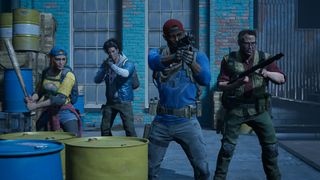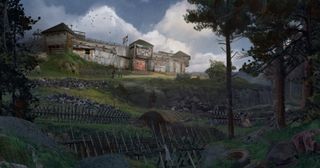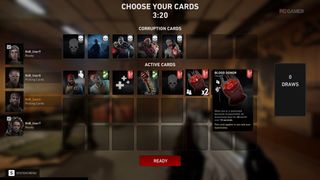I can't stress enough that Back 4 Blood is Left 4 Dead 3
A sequel in all but name, the co-op zombie FPS is back.
ABOVE: Edited gameplay footage from our playthrough of the forthcoming alpha.
Losing the rights to the thing you made is a surprisingly common situation in the games industry.
Obsidian Entertainment is one recent example—last year the studio released sci-fi RPG The Outer Worlds after years of constant praise for Fallout: New Vegas, which it couldn't continue. Elsewhere, Atari held the rights to Rollercoaster Tycoon, so Frontier corkscrewed right around them and made Planet Coaster. Two or three of these spiritual reboots pop up each year: Two Point Hospital, Phoenix Point, Yooka-Laylee. Further back, BioShock.
Left 4 Dead creators Turtle Rock Studios found themselves in this same license limbo over the last decade, having carried a genre-defining co-op zombie shooter to term in 2008 before passing their baby to Valve, who's mostly slept on the franchise (there was a surprise community update in September).

In Back 4 Blood, you feel Turtle Rock's pent-up passion for zombie co-op. The shooter unapologetically walks in the footsteps of what we played in '08 and '09. It's is a more visually polished game, of course, but its basic parts are identical: four-player, run-and-gun shooting through criss-crossing urban and outdoor post-apocalyptica (in the first 15 minutes: apartment, rooftop, construction site, haphazard parking lot), conventional military weapons, and a procedurally-driven "Director" AI overseeing the action, pulling the strings. More Kubrick than Spielberg, this Director.
The Cleaners are stationed in a stronghold called Fort Hope, the nucleus of the setting.
Atop that foundation, even finer Left 4 Dead details have been transfused into Back 4 Blood. When you heal yourself with a medkit, the camera pops out into third-person until the bandage-wrap animation completes. You can grab a defibrillator to revive downed teammates quickly and, if they die outright, they can be freed later on in the level to rejoin the team. The special infected include a wobbling vomit-launcher, a wall-crawling "Hocker" that can root you in place, and the Bruiser, whose swollen right arm creates almost the same silhouette as L4D2's Charger. Saferooms are scrawled with fearful and funny graffiti. Even some of the same weapons are back for blood: Molotov, fire axe, machete, AK, M4, Uzi, a set of throwable firecrackers that draw common infected away from you.

It's a long list of resemblances. After playing the imminent alpha for a few hours, one question I'm left with is how many new ideas Back 4 Blood will need to be a great, fresh experience. Will Left 4 Dead actually hold up well as a style of game in 2021? When I replayed that aforementioned community update in September, it surprised me how poorly some aspects of the shooter had aged. Sudden "crescendos" of action felt tedious. Guns lacked personality and nuance. My biggest gripe with Left 4 Dead in retrospect is that you're shooting almost constantly from beginning to end, with only a saferoom finish line there to supply a moment of pacing. It can leave you with a rabid, frayed brain, something I felt in this early version of Back 4 Blood too.
PC Gamer Newsletter
Sign up to get the best content of the week, and great gaming deals, as picked by the editors.
It's possible that Back 4 Blood could inherit some of Left 4 Dead's lack of rhythm. The alpha did show a couple signs of this being an issue—on three occasions when I ran maybe 30 meters ahead of my teammates, I encountered absolutely zero infected, something that Left 4 Dead routinely punished. And in a big finale event on a massive, three-level cruise ship, my team had the opposite problem: infected streamed in non-stop, without a single break in the action. It was like swimming against the flow of a gushing zombie river.

But spawn behavior is the sort of thing that can be ironed out during development. Maybe the more critical question is what Back 4 Blood's overall campaign structure will look like, and whether it'll meaningfully differ from Left 4 Dead's roughly symmetrical chapter-segments. Turtle Rock told me that Back 4 Blood will have a "bigger" story than Left 4 Dead, one not simply about fleeing the infected, but about taking back the world from them. You're not a survivor, you're a "Cleaner," an immune fighter who's seemingly working with a remnant military force.
We do know that Back 4 Blood won't be an open-ended, globetrotting World War Z affair. The Cleaners are stationed in a stronghold called Fort Hope, the nucleus of the setting, and from there you'll "take missions and go out into the city," rescue people, and go out into the world, studio co-founder Chris Ashton told me. "There's NPCs, there's dialogue … You know at the outset of each mission what your objective is, and sometimes that objective goes all wrong … we've got intros and outros to missions, we've got radio communications, we've got our dynamic VO system."
What I played was light on storytelling, but in the final chapter of the alpha a convoy of military vehicles roll up to a cruise ship terminal, guns blazing, asking us to run back into danger and blow up the cruise ship. I'm hoping there's a lot more worldbuilding and storytelling moments to chew on like this—Left 4 Dead was plotless, relying almost entirely on light environmental cues to string together a theme. The best tool at Turtle Rock's disposal will be the wider roster of eight characters, who the studio promises will each cast their own perspective on the environment, contributing some replay value through different voice lines.

Maybe the most novel mechanical trick Back 4 Blood has up its sleeve is a light card-based system, if you can believe it. It works almost like a soft pick-and-ban scheme that you'd find in Dota 2 or Rainbow Six Siege. Before each match the AI lays down a few cards (between two and four, in my sessions) that announce which enemies or conditions the next mission will include, like fog. In response, each player throws down a handful of their own modifying buffs, from straightforward boosts to ammo or health capacity to more interesting tweaks like healing on melee kills. When my teammates and I died, I liked that this system replaced some of the tedium of having to repeat a mission with strategizing—after each death, you can toss another card into play to improve your odds of success. These cards can be found hidden in levels or unlocked as a form of progression.

Two more smaller-but-significant changes shouldn't go unnoticed: 1) you can sprint now; 2) guns have iron sights, partly to accommodate a new weapon attachments system. I still ended up playing Back 4 Blood mostly without ironsights—the missions I played didn't exactly encourage us to stand still and aim. But the addition of modular weapon attachments you can find in the environment or purchase before each mission is welcome, partly because it'll force more complex decisions than the rock-paper-scissors of Left 4 Dead's rifle-shotgun-sniper weapon set.
How much Back 4 Blood does ultimately alter the experience it's unapologetically resuscitating hinges on Turtle Rock's promises of a bigger experience that plays out over the course of a campaign, almost all of which has yet to be revealed. We also don't know if Back 4 Blood will be moddable, or how far down the "service game" path Turtle Rock and Warner Bros. will take it (will there be a season pass?), questions they weren't ready to answer quite yet. You'll be able to judge some of this for yourself very soon: the alpha just went live today, and runs through December 21st.

Evan's a hardcore FPS enthusiast who joined PC Gamer in 2008. After an era spent publishing reviews, news, and cover features, he now oversees editorial operations for PC Gamer worldwide, including setting policy, training, and editing stories written by the wider team. His most-played FPSes are CS:GO, Team Fortress 2, Team Fortress Classic, Rainbow Six Siege, and Arma 2. His first multiplayer FPS was Quake 2, played on serial LAN in his uncle's basement, the ideal conditions for instilling a lifelong fondness for fragging. Evan also leads production of the PC Gaming Show, the annual E3 showcase event dedicated to PC gaming.
Most Popular





